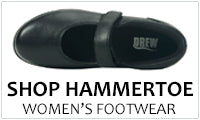What Is HAMMERTOE?
The smallest four toes of each foot have three bony segments connected by two joints, just as the fingers do. Hammertoe is a deformity in which one or more of the small toes develops a bend at the joint between the first and second segments so that the tip of the toe turns downward, making it looks like a hammer or claw. The second toe is affected most often. Most hammertoes are caused by wearing ill-fitting, tight or high-heeled shoes over a long period of time. Shoes that don't fit well can crowd the toes, putting pressure on the middle toes and causing them to curl downward. Hammertoe also can be caused by a bunion, which is the knobby bump that sometimes develops at the side of the big toe. A bunion causes the big toe to bend toward the other toes. The big toe can then overlap and crowd the smaller toes. Occasionally, a hammertoe is inherited or caused by arthritis in the toe joint. If the toes remain in the hammertoe position for long periods, the tendons on the top of the foot will tighten over time because they are not stretched to their full length. Eventually, the tendons shorten enough that the toe stays bent, even when shoes are not being worn.
Symptoms
The symptoms of hammertoe include:
- A curling toe
- Pain or discomfort in the toes and ball of the foot or the front of the leg, especially when toes are stretched downward
- Thickening of the skin above or below the affected toe with the formation of corns or calluses
- Difficulty finding shoes that fit well
In its early stages, hammertoe is not obvious. Frequently, hammertoe does not cause any symptoms except for the claw-like toe shape.
Diagnosis
Most health care professionals can diagnose hammertoe simply by examining your toes and feet. X-rays of the feet are not needed to diagnose hammertoe, but they may be useful to look for signs of some types of arthritis (such as rheumatoid arthritis) or other disorders that can cause hammertoe . If the deformed toe is very painful, your doctor may recommend that you have a fluid sample withdrawn from the joint with a needle so the fluid can be checked for signs of infection or gout (arthritis from crystal deposits).
Expected Duration
Unless treated, hammertoe is permanent.
Prevention
Most cases of hammertoe can be prevented by wearing shoes that fit properly and give the toes plenty of room. Some recommended guidelines include:
- Avoid shoes with pointed or narrow toes.
- Avoid shoes that are too tight or short.
- Avoid high-heeled shoes, which can force the toes forward.
- If the shoes hurt, don't wear them.
- Choose wide shoes with wide or boxy toes.
- Choose shoes that are a half-inch longer than your longest toe.
If you notice the beginning signs of hammertoe, you may be able to prevent the tendons from tightening by wearing toe-friendly shoes, by flattening your toes regularly, and by soaking your feet every day in warm water, then stretching your toes and ankles by pointing your toes. Foot exercises also can help to maintain or restore the flexibility of the tendons. One simple exercise is to place a small towel on the floor and then pick it up using only your toes. You also can grasp at carpet with your toes or curl your toes up and down repeatedly.
Treatment
Treating hammertoe involves straightening the toe, making tendons in the toes flexible again, and preventing the problem from returning. Some simple treatments include:
- Splinting the toe to keep it straight and to stretch the tendons of the foot
- Using over-the-counter pads, cushions or straps to decrease discomfort
- Exercising the toes to relax the foot tendons (a session with a physical therapist may help you get started with foot exercises)
- Wearing shoes that fit properly and allow toes plenty of room to stretch out
In advanced cases in which the toe has become stiff and permanently bent, the toe can be straightened with surgery. One type of surgery involves removing a small section of the toe bone to allow the toe to lie flat. Surgery for hammertoe usually is classified as a cosmetic procedure. Cosmetic foot surgeries sometimes result in complications such as pain or numbness, so it's better to treat the problem with a shoe that fits properly.
When To Call A Professional
Make an appointment with a health care professional if you experience pain in your toes or feet that lasts longer than several days. If one or more of your toes begins curling, see your doctor or a podiatrist (foot doctor) to discuss early treatment to avoid hammertoes . If you already have hammertoe and find it bothersome, call a health care professional for an evaluation. If you have diabetes and experience any toe or foot pain or toe problems, including hammertoes or corns, see a physician promptly to avoid potential infection or skin complications.
Prognosis
Hammertoe is often a harmless and painless condition. Although the toe may be curled permanently, hammertoe should not cause any long-term problems other than a more difficult time finding shoes that fit. If hammertoes is treated and preventive measures are followed, the condition should not return. Wearing tight or constricting shoes can cause hammertoe to return. Reprinted with the permission of the Harvard Medical School

